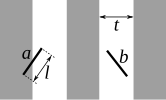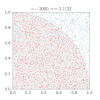圓周率
| 數學嘅數 |
| 基本 |
|
|
| 延伸 |
| 其他 |
|
圓周率 π = 3.141592653… |


圓周率,一般用 π 表示,係一個喺數學同物理學普遍存在嘅常數,大約等於 3.14159。佢嘅定義係平面幾何(或者歐幾里得幾何)入面圓形嘅圓周同直徑嘅比例,亦等於圓形嘅面積同半徑平方嘅比例。佢係精確計算圓周長、圓面積、球體積等幾何量嘅關鍵。喺分析學上, 可以定義為最細嘅 令到 。
古代最初估計圓周率係 ,正所謂「周三徑一」[2][3]。後尾有人發現有理數 可以當做圓周率嘅近似值,叫做約率。中國南北朝數學家祖沖之發現有理數 ()更加接近(只係大咗 或接近千萬分之一),所以叫做密率。
日本數學家三上義夫為咗記念祖沖之嘅成就,提議將呢個近似值叫做祖率。喺一般應用, 或約率 就已經夠數,但係工程學成日用 (5位有效數字)或者 (6位有效數字)。至於密率 就係一個易記啲、精確到7位有效數字嘅分數。
1650年,約翰·沃利斯搵到
1674年,萊布尼茲搵到
- 3.8,29,44,0,47,25,53,7,24,57,
36,17,43,4,29,7,1,3,41,17,
52,36,12,14,36,44,51,5,15,33,
7,23,59,9,13,48,22,12,21,45,
22,56,47,39,44,28,37,58,23,21,
11,56,33,22,4,42,31,6,6,4。[4]
定義
[編輯]因為任何圓形都係相似形,所以圓周同直徑嘅比例係一個常數,叫做圓周率,符號係 ,數值大約係,呢個係目前公認嘅定義。
無論圓嘅大細點樣,比值 為恆值。如果個圓嘅直徑變為頭先嘅二倍,佢嘅周長亦都變為二倍,比值 唔變。而家 比值定義隱性咁樣用咗歐幾里得幾何入面比值啲定理,雖然個圓嘅定義可以擴展到任意曲面(即唔係歐幾里得幾何),但呢啲圓都唔再符合定律 。[5]
另外有啲數學家建議用圓周÷半徑嚟定義圓周率,符號係 ,數值大約係,即係。
搵圓周率數值嘅現代方法
[編輯]Monte Carlo方法
[編輯]Monte Carlo方法即係重覆好多次隨機嘅過程去搵答案,可以用嚟搵嘅近似值[6]。Buffon嘅針係一個例子:一個平面上面畫咗一柞平行線,每條相隔t個單位,隨機掉n次每條長度係l個單位嘅針落去,記錄啲針同平行線相交嘅次數係x,噉π大約就係[7]:
另一個方法係係畫一個正方形外接住一個圓,隨機擺啲點落去,喺圓入面嘅點占嘅比例大約係[8]。
睇埋
[編輯]參考
[編輯]- ↑ https://archive.org/stream/Pi_to_100000000_places/pi.txt
- ↑ 《周髀算經》。
- ↑ 楊炯。《渾天賦》。
- ↑ 60進制下60個小數位嘅嗰圓周率
- ↑ 引用錯誤 無效嘅
<ref>標籤;無文字提供畀叫做Arndt嘅參照 - ↑ Arndt & Haenel 2006, p. 39
- ↑ Ramaley, J.F. (October 1969). "Buffon's Noodle Problem". The American Mathematical Monthly. 76 (8): 916–918. doi:10.2307/2317945. JSTOR 2317945.
- ↑ Arndt & Haenel 2006, pp. 39–40Posamentier & Lehmann 2004, p. 105
來源
[編輯]- Andrews, George E.; Askey, Richard; Roy, Ranjan (1999). Special Functions. Cambridge: University Press. ISBN 978-0-521-78988-2.
- Arndt, Jörg; Haenel, Christoph (2006). Pi Unleashed. Springer-Verlag. ISBN 978-3-540-66572-4. 喺5 June 2013搵到. English translation by Catriona and David Lischka.
- Ayers, Frank (1964). Calculus. McGraw-Hill. ISBN 978-0-07-002653-7.
- Bailey, David H.; Plouffe, Simon M.; Borwein, Peter B.; Borwein, Jonathan M. (1997). "The quest for PI". The Mathematical Intelligencer. 19 (1): 50–56. CiteSeerX 10.1.1.138.7085. doi:10.1007/BF03024340. ISSN 0343-6993. S2CID 14318695.
- Beckmann, Peter (1989) [1974]. History of Pi. St. Martin's Press. ISBN 978-0-88029-418-8.
- Berggren, Lennart; Borwein, Jonathan; Borwein, Peter (1997). Pi: a Source Book. Springer-Verlag. ISBN 978-0-387-20571-7.
- Boeing, Niels (14 March 2016). "Die Welt ist Pi" [The World is Pi]. Zeit Online (德文). 原先內容歸檔喺17 March 2016.
Die Ludolphsche Zahl oder Kreiszahl erhielt nun auch das Symbol, unter dem wir es heute kennen: William Jones schlug 1706 den griechischen Buchstaben π vor, in Anlehnung an perimetros, griechisch für Umfang. Leonhard Euler etablierte π schließlich in seinen mathematischen Schriften. [The Ludolphian number or circle number now also received the symbol under which we know it today: William Jones proposed in 1706 the Greek letter π, based on perimetros [περίμετρος], Greek for perimeter. Leonhard Euler firmly established π in his mathematical writings.]
- Borwein, Jonathan; Borwein, Peter (1987). Pi and the AGM: a Study in Analytic Number Theory and Computational Complexity. Wiley. ISBN 978-0-471-31515-5.
- Boyer, Carl B.; Merzbach, Uta C. (1991). A History of Mathematics (第2版). Wiley. ISBN 978-0-471-54397-8.
- Bronshteĭn, Ilia; Semendiaev, K.A. (1971). A Guide Book to Mathematics. Verlag Harri Deutsch. ISBN 978-3-87144-095-3.
- Eymard, Pierre; Lafon, Jean Pierre (1999). The Number Pi. American Mathematical Society. ISBN 978-0-8218-3246-2., English translation by Stephen Wilson.
- Gupta, R.C. (1992). "On the remainder term in the Madhava–Leibniz's series". Ganita Bharati. 14 (1–4): 68–71.
- Howe, Roger (1980), "On the role of the Heisenberg group in harmonic analysis", Bulletin of the American Mathematical Society, 3 (2): 821–844, doi:10.1090/S0273-0979-1980-14825-9, MR 0578375.
- Joseph, George Gheverghese (1991). The Crest of the Peacock: Non-European Roots of Mathematics. Princeton University Press. ISBN 978-0-691-13526-7. 喺5 June 2013搵到.
- Posamentier, Alfred S.; Lehmann, Ingmar (2004). Pi: A Biography of the World's Most Mysterious Number. Prometheus Books. ISBN 978-1-59102-200-8.
- Reitwiesner, George (1950). "An ENIAC Determination of pi and e to 2000 Decimal Places". Mathematical Tables and Other Aids to Computation. 4 (29): 11–15. doi:10.2307/2002695. JSTOR 2002695.
- Remmert, Reinhold (2012). "Ch. 5 What is π?". 出自 Heinz-Dieter Ebbinghaus; Hans Hermes; Friedrich Hirzebruch; Max Koecher; Klaus Mainzer; Jürgen Neukirch; Alexander Prestel; Reinhold Remmert (編). Numbers. Springer. ISBN 978-1-4612-1005-4.
- Rossi, Corinna (2004). Architecture and Mathematics in Ancient Egypt. Cambridge: University Press. ISBN 978-1-107-32051-2.
- Roy, Ranjan (1990). "The Discovery of the Series Formula for pi by Leibniz, Gregory, and Nilakantha". Mathematics Magazine. 63 (5): 291–306. doi:10.2307/2690896. JSTOR 2690896.
- Schepler, H.C. (1950). "The Chronology of Pi". Mathematics Magazine. 23 (3): 165–170 (Jan/Feb), 216–228 (Mar/Apr), and 279–283 (May/Jun). doi:10.2307/3029284. JSTOR 3029284.. issue 3 Jan/Feb, issue 4 Mar/Apr, issue 5 May/Jun
- Thompson, William (1894), "Isoperimetrical problems", Nature Series: Popular Lectures and Addresses, II: 571–592
其他書
[編輯]- Blatner, David (1999). The Joy of Pi. Walker & Company. ISBN 978-0-8027-7562-7.
- Borwein, Jonathan; Borwein, Peter (1984). "The Arithmetic-Geometric Mean and Fast Computation of Elementary Functions" (PDF). SIAM Review. 26 (3): 351–365. CiteSeerX 10.1.1.218.8260. doi:10.1137/1026073.
- Borwein, Jonathan; Borwein, Peter; Bailey, David H. (1989). "Ramanujan, Modular Equations, and Approximations to Pi or How to Compute One Billion Digits of Pi". The American Mathematical Monthly (Submitted manuscript). 96 (3): 201–219. doi:10.2307/2325206. JSTOR 2325206.
- Chudnovsky, David V. and Chudnovsky, Gregory V., "Approximations and Complex Multiplication According to Ramanujan", in Ramanujan Revisited (G.E. Andrews et al. Eds), Academic Press, 1988, pp. 375–396, 468–472
- Cox, David A. (1984). "The Arithmetic-Geometric Mean of Gauss". L'Enseignement Mathématique. 30: 275–330.
- Delahaye, Jean-Paul (1997). Le Fascinant Nombre Pi. Paris: Bibliothèque Pour la Science. ISBN 2-902918-25-9.
- Engels, Hermann (1977). "Quadrature of the Circle in Ancient Egypt". Historia Mathematica. 4 (2): 137–140. doi:10.1016/0315-0860(77)90104-5.
- Euler, Leonhard, "On the Use of the Discovered Fractions to Sum Infinite Series", in Introduction to Analysis of the Infinite. Book I, translated from the Latin by J.D. Blanton, Springer-Verlag, 1964, pp. 137–153
- Hardy, G. H.; Wright, E. M. (2000). An Introduction to the Theory of Numbers (第fifth版). Oxford, UK: Clarendon Press.
- Heath, T.L., The Works of Archimedes, Cambridge, 1897; reprinted in The Works of Archimedes with The Method of Archimedes, Dover, 1953, pp. 91–98
- Huygens, Christiaan, "De Circuli Magnitudine Inventa", Christiani Hugenii Opera Varia I, Leiden 1724, pp. 384–388
- Lay-Yong, Lam; Tian-Se, Ang (1986). "Circle Measurements in Ancient China". Historia Mathematica. 13 (4): 325–340. doi:10.1016/0315-0860(86)90055-8.
- Lindemann, Ferdinand (1882). "Ueber die Zahl pi". Mathematische Annalen. 20 (2): 213–225. doi:10.1007/bf01446522. S2CID 120469397. 原著喺22 1月 2015歸檔.
- Matar, K. Mukunda; Rajagonal, C. (1944). "On the Hindu Quadrature of the Circle" (Appendix by K. Balagangadharan)". Journal of the Bombay Branch of the Royal Asiatic Society. 20: 77–82.
- Niven, Ivan (July 1947). "A Simple Proof that pi Is Irrational". Bulletin of the American Mathematical Society. 53 (7): 507. doi:10.1090/S0002-9904-1947-08821-2.
- Ramanujan, Srinivasa (1914). "Modular Equations and Approximations to π". Quarterly Journal of Pure and Applied Mathematics. XLV: 350–372. Reprinted in Ramanujan, Srinivasa (2015) [1927]. Hardy, G. H.; Seshu Aiyar, P. V.; Wilson, B. M. (編). Srinivasa Ramanujan: Collected Papers. Cambridge University Press. pp. 23–29. ISBN 978-1-107-53651-7.
- Shanks, William, Contributions to Mathematics Comprising Chiefly of the Rectification of the Circle to 607 Places of Decimals, 1853, pp. i–xvi, 10
- Shanks, Daniel; Wrench, John William (1962). "Calculation of pi to 100,000 Decimals". Mathematics of Computation. 16 (77): 76–99. doi:10.1090/s0025-5718-1962-0136051-9.
- Tropfke, Johannes (1906). Geschichte Der Elementar-Mathematik in Systematischer Darstellung [The history of elementary mathematics] (德文). Leipzig: Verlag Von Veit.
- Viete, Francois, Variorum de Rebus Mathematicis Reponsorum Liber VII. F. Viete, Opera Mathematica (reprint), Georg Olms Verlag, 1970, pp. 398–401, 436–446
- Wagon, Stan (1985). "Is Pi Normal?". The Mathematical Intelligencer. 7 (3): 65–67. doi:10.1007/BF03025811. S2CID 189884448.
- Wallis, John (1655–1656). Arithmetica Infinitorum, sive Nova Methodus Inquirendi in Curvilineorum Quadratum, aliaque difficiliora Matheseos Problemata (拉丁文). Oxford. Reprinted in Opera Mathematica.第1卷. Oxford: E Theatro Sheldoniano. 1695. pp. 357–478.
- Zebrowski, Ernest (1999). A History of the Circle: Mathematical Reasoning and the Physical Universe. Rutgers University Press. ISBN 978-0-8135-2898-4.

